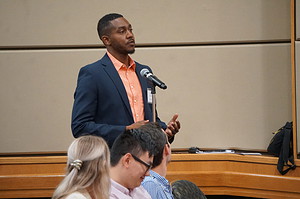View Larger Image

Sunny Singh, M.D. (third from left) answers a question during a panel at the 2023 fall sickle cell symposium.
Image by Benjamin Waldrum
Sickle Cell Disease Symposium Looks Ahead to “New Era”
| The University of Arkansas for Medical Sciences (UAMS) hosted its annual Sickle Cell Symposium on Sept. 12, bringing together leading researchers, clinicians, patients and community advocates to share the latest advancements in sickle cell disease and treatment.
The fall event, held in the 12th floor auditorium of the Jackson T. Stephens Neurosciences & Spine Institute on UAMS’ Little Rock campus, drew nearly 100 attendees, with more attending virtually via Zoom.
“This symposium stands as a testament to the dedication and collaboration of experts from around the world who are united in their mission to take on these challenges posed by sickle cell disease,” said Sunny Singh, M.D., director of the UAMS Adult Sickle Cell Program. “Today we stand at the brink of a new era, which is marked by breakthroughs that inspire hope and rejuvenate our efforts. Together, we pave the way towards a future where the word ‘cure’ is no longer a distant dream, but a tangible reality.”

Phillip Sanders, whose sickle cell disease was cured after a stem cell transplant, asks a question during a panel at the symposium.Benjamin Waldrum
Sickle cell disease is a group of inherited red blood cell disorders where the red blood cells become hard and sticky, resulting in a C-shape or “sickle.” When sickle cells travel to small blood vessels, they get trapped and block blood flow to the area. This results in pain and may lead to other problems such as infection, acute chest syndrome and stroke.
Approximately 100,000 Americans are affected by sickle cell disease, according to the Centers for Disease Control and Prevention. Sixty percent of those are adults. There are more than 1,000 Arkansans with sickle cell disease, with roughly 20 new cases detected each year.
The overwhelming majority of sickle cell disease patients are Black.
The symposium hosted multiple presentations on care and treatment for sickle cell disease:
- “Advancements in Sickle Cell Research and Treatment: Paving the Way Towards a Cure,” by Santosh Saraf, M.D., associate professor of medicine and director of translational research for the Sickle Cell Center of the University of Illinois at Chicago
- “Gene Therapy for Sickle Cell Disease — An Overview,” by Shalini Shenoy, M.D., professor of pediatrics at Washington University in St. Louis and director of the Pediatric Stem Cell Transplant Program at St. Louis Children’s Hospital
- “Moving Forward: UAMS Adult Sickle Cell Program Future Directions,” by Muthu Veera Kumaran, M.D., formerly Muthu Veeraputhiran, director of the hematology and oncology section and clinical program director for stem cell transplantation and cellular therapy at the UAMS Winthrop P. Rockefeller Cancer Institute
A panel discussion followed, featuring Singh and the other presenters and moderated by Lindsey Dayer, Pharm.D., associate professor and director of experiential education in the UAMS College of Pharmacy, and clinical pharmacist for the UAMS Adult Sickle Cell Program. Panelists responded to multiple questions from the audience, ranging from more detail on emerging gene therapy, dealing with treatment side effects and cost of care.
The UAMS Adult Sickle Cell Clinical Program launched in 2014. Since then, the program has helped treat hundreds of patients and families. It collaborates with the pediatric Sickle Cell Disease Program at Arkansas Children’s and often receives patients when they age out of the program. Overall, the UAMS program maintains more than 250 active patients across the state.